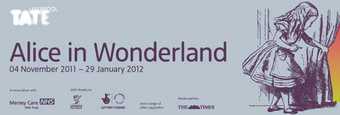Charles Lutwidge Dodgson – a gifted logician, mathematician and amateur photographer – arrived at his nom de plume, Lewis Carroll, by reversing his two first names and translating them back into English from Latin. Isn’t it fitting that the name on the cover of Alice’s Adventures in Wonderland (1865) and Through the Looking-Glass (1871) should conceal some kind of wordplay? Both books are full of jokes about naming and slippery identities – problems that are in each closely related. Alice, Carroll’s questing heroine, is continually coming up against the unpredictability of speech and text. As W.H. Auden wrote of the two wildly popular books: “One of the most important and powerful characters is not a person but the English language.”
Although intended for the entertainment of Alice Liddell, the young daughter of the dean of Christ Church College, Oxford (where Carroll lectured in mathematics), several generations of writers and philosophers have taken the Alice books’ focus on language and perception extremely seriously. Look, for example, to James Joyce’s Finnegans Wake (1939), and you will find coded allusions to Dodgson’s pen name – “Lewd’s carol”, “loose carollaries” – peppered throughout. Or read the essays of Ferdinand de Saussure, the Swiss father of structuralism who 100 years ago argued that a word’s meaning is grounded only in convention, and you may feel as though Carroll’s characters already covered a lot of the same territory. “Must a name mean something?” Alice asks Humpty Dumpty, only to get this answer: “When I use a word… it means just what I choose it to mean – neither more nor less.”
At the beginning of the 1960s artists started to become interested in similar ideas, which were sometimes transmitted via the newly translated writings of Roland Barthes, Jacques Derrida and other European post-structuralists. Texts no longer seemed so stable – just as Alice finds out, the written word can be fluid and often treacherous. Text also came to seem unavoidably material. We encounter this feeling in the Alice books, which, illustrated by Punch cartoonist Sir John Tenniel, are both fantastically visual things, though the illustrations are less radical than Carroll’s own textual approaches, the inventiveness of which has shades of Laurence Sterne’s Tristam Shandy (1759–69). There is concrete poetry (a mouse’s “tale” is set in the shape of a “tail”), while a quiet voice is rendered as tiny text and the narrative is periodically interrupted mid-sentence by clouds of asterisks. These textual strategies give an antic display of the belief that “language is not transparent”, as goes the title of a 1970 wall piece by Mel Bochner, one of the first generation of artists to be captivated by both the material potential of text and its endless ambiguities.
In 1963, in one of the earliest definitions of what a few years later would come to be known as conceptual art, the philosopher and artist Henry Flynt had claimed that “since ‘concepts’ are closely bound up with language, concept art is a kind of art of which the material is language”. Much of the work that followed – from Lawrence Weiner’s gnomic wall pieces to On Kawara’s date paintings – took language as a material starting point. Flynt is making an argument for an art of ideas rather than objects, an art which is not necessarily tied to a physical artefact. A little like the Alice books, the story of the early years of conceptual art is one that involves an alarming series of dematerialisations. Indeed, the art historian Paul Wood has compared conceptual art with the Cheshire cat, “dissolving away until nothing is left but a grin”.
Carroll’s wordplay always has a target, as the conceptual artist Adrian Piper recognised when she described Alice in Wonderland as an “invaluable primer to social reality, better than Kafka”. His punning frequently collapses authority into absurdity: “reading and writing” becomes “reeling and writhing”, legal hearings descend into farce, a teacherly turtle becomes a tortoise (because he “taught us”) – misunderstandings abound.
Much early text-based art is likewise invested in focusing on definitions or wordplay as a mode of critique. Joseph Kosuth’s work from the mid-1960s, for example, continually questions the way language affects how we see the world. One series, begun when the New York-based artist was only twenty, presents a working clock alongside an identically sized photograph next to dictionary definitions for the words “object”, “machination” and “time”. Which version of the clock is the “real” thing? Does understanding reside in objects, representations or words? Less academic in presentation, but no less serious in intention, Bruce Nauman’s Run from Fear, Fun from Rear 1972 presents the lines in yellow and pink neon, glowing above one another so that the eye’s movement between the two makes the texts seem to merge. The fixation and medium is echoed more bluntly in Tracey Emin’s 1998 neon diptych Is Anal Sex Legal and Is Legal Sex Anal. Like the best word games, both of these pieces achieve confusion through concision, scrambling proscribed pleasures to the point of farce. Perhaps neither is so far from Alice wondering whether cats eat bats or bats eat cats.
The writer Marina Warner has noted that riddles, like nonsense verse and nursery rhymes, “are as ancient as anything ever told, and they occur in every culture”. Probably the best-known riddle in Carroll’s books is this one, posed to Alice by the Mad Hatter: “Why is a raven like a writing-desk?” It has sometimes been suggested that the answer is a literary one, “Because Poe wrote on both”, but, as Carroll explained in his preface to the 1896 edition of Alice in Wonderland, this isn’t the case: “The Riddle, as originally invented, had no answer at all.” A riddle without an answer is not so much a riddle as a prompt for speculation; it is also a kind of deception, a ruse that keeps you guessing. In 2006 the French artist Loris Gréaud employed the line as a title for a work of his own, a work which was similarly unverifiable: a series of nano-sculptures, displayed in a bespoke micro-museum, too small to be viewed by the naked eye. Viewers had to take their existence on trust – were they looking at anything more than an empty plinth? Gréaud, like several of his contemporaries, plays the part of the trickster who never cracks a smile, adopting the guise of expertise in order to be granted a certain authority by the viewer.

Installation view of Lawrence Weiner’s MATTER CAUSED TO CEASE TO FUNCTION AS IT HAD at Regen Projects, Los Angeles (1995)
Courtesy Regen Projects © Lawrence Weiner
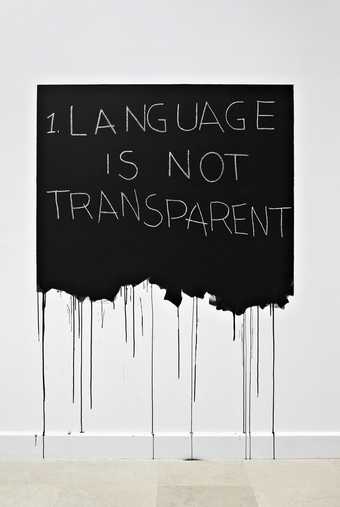
Mel Bochner
Language Is Not Transparent 1970
Chalk and paint
Courtesy Los Angeles County Museum of Art © Mel Bochner
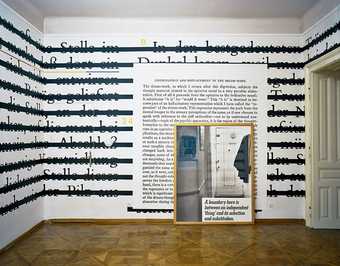
Installation view of Joseph Kosuth’s Zero and Not exhibition at the Sigmund Freud Museum, Vienna (1989)
Courtesy Sigmund Freud Museum, Vienna, and Sean Kelly Gallery, New York © Joseph Kosuth
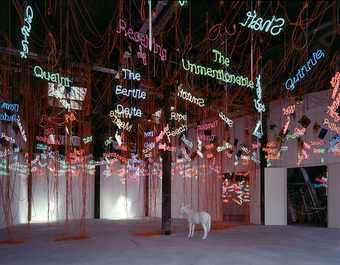
Installation view of Jason Rhoades’s My Madinah – in Pursuit of My Ermitage 2004 at Sammlung Hauser & Wirth, Lokremise, St Gallen
Courtesy Hauser & Wirth © Estate of Jason Rhoades
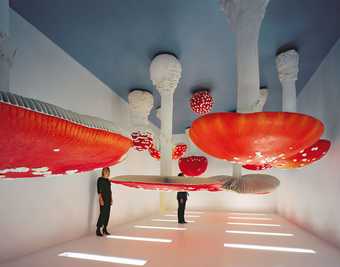
Installation view of Carsten Höller’s Upside Down Mushroom Room at Fondazione Prada
Courtesy Air de Paris, Paris © Carsten Höller
Whether or not these artists acknowledge the influence of Alice in Wonderland and Through the Looking-Glass on their own work, they often share the books’ concerns with the unstableness of objects and the unreliability of perception. While Edmund Husserl and Maurice Merleau-Ponty, the central figures in phenomenology, are more regularly name-checked as central to such preoccupations, especially in relation to the rationality of 1960s minimalist sculpture, the Alice books’ crazed logic is often closer in spirit to more recent work. As Alice discovers after shrinking to ten inches high, our understanding is extremely sensitive to our own size in relation to the object we are faced with.
An example of a project that was developed according to this principle is Dominique Gonzalez- Foerster’s contribution to the 2007 Skulptur Projekte Münster in Germany, Roman de Münster (A Münster Novel) 2007, which collapsed the exhibition’s 30-year history into a miniature “novel”: a selection of sculptures from past editions reproduced at 25 per cent their original size. This outdoor tableau played havoc with your sense of perspective (both historical and physical), but also insinuated that authority often resides in scale – that size is never neutral. Some of the work of Gonzalez-Foerster’s contemporaries – such as Pierre Huyghe, with his oversize doors dancing around the exhibition space, or Carsten Höller – could be seen as an attempt to literalise the terrain of the Alice books. Since the early 1990s the Brussels-born Höller has shaped experiences more than objects, and the objects that he does produce resemble scientific tools, precision instruments in stainless steel. A great deal of this research-based practice is directed towards understanding the construction of experience – how can we say that what we’re feeling is real at all?
This is the anxiety that thrums through Carroll’s books: “You know very well you’re not real,” Tweedledum tells Alice. “I am real!” she replies, and begins to cry. The more general question that the two books pose is whether anyone has any kind of mastery over language, and whether this is ever really possible. “The question is,” as Alice says to Humpty Dumpty, “whether you can make words mean so many different things.”

